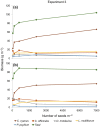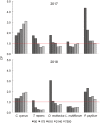Do plant communities show constant final yield?
- PMID: 35796439
- PMCID: PMC9788247
- DOI: 10.1002/ecy.3802
Do plant communities show constant final yield?
Abstract
Total biomass production of plant monocultures growing over a range of densities and harvested after a period of growth increases monotonically with density and then levels out at higher densities. This pattern is called constant final yield (CFY) and is considered one of the most general phenomena in plant ecology. If CFY applies to plant communities, it would be a key to understanding and predicting many community-level phenomena. We tested two primary hypotheses experimentally: (1) Mixtures of several species show CFY. (2) If so, the proportion of biomass production by the component species in a mixture does not change at densities above the density that reaches CFY. We performed a series of glasshouse experiments over 3 years using a "community density series," in which the overall density of five species was varied while their proportions remained unchanged. In the first experiment, we grew a mixture of annual and perennial herbaceous species in mesocosms, and all species were also grown in monocultures at the corresponding densities. A similar experiment was performed in the second and third years, but only with annuals. A third experiment with mixtures only was performed in pots over 2 years. In all cases, aboveground biomass was harvested, separated by species, dried, and weighed. Perennials with underground storage organs produced maximum aboveground biomass at low or intermediate densities. In the second experiment, two of the species produced maximum biomass at the second-highest density in monoculture, while mixtures of all five species showed classical CFY behavior, and the contribution of the species to the mixture changed very little above the lowest density producing CFY. The results of the third experiment were also consistent with the hypotheses. In conclusion, CFY in aboveground biomass production was observed in communities of annual species, and the contribution of the individual species was relatively insensitive to an increase in density above that reaching CFY, i.e., competitive performance of the species changed with density until CFY was reached. Evidence for CFY was stronger in mixture than in monoculture. Coexistence theory must include density as well as frequency dependence if densities are below CFY.
Keywords: biomass production; community regulation; density dependence; plant populations.
© 2022 The Authors. Ecology published by Wiley Periodicals LLC on behalf of The Ecological Society of America.
Conflict of interest statement
The authors declare no conflict of interest.
Figures





References
-
- Adler, P. B. , Ellner S. P., and Levine J. M.. 2010. “Coexistence of Perennial Plants: An Embarrassment of Niches.” Ecology Letters 13: 1019–29. - PubMed
-
- Berendse, F. , and Möller F.. 2009. “Effects of Competition on Root–Shoot Allocation in Plantago lanceolata L.: Adaptive Plasticity or Ontogenetic Drift?” Plant Ecology 201: 567–73.
-
- Casper, B. B. , Cahill J. F., and Hyatt L. A.. 1998. “Above‐Ground Competition Does Not Alter Biomass Allocated to Roots in Abutilon Theophrasti.” New Phytologist 140: 231–8. - PubMed
-
- Chesson, P. 2000. “Mechanisms of Maintenance of Species Diversity.” Annual Review of Ecology and Systematics 31: 343–66.
Publication types
MeSH terms
LinkOut - more resources
Full Text Sources
